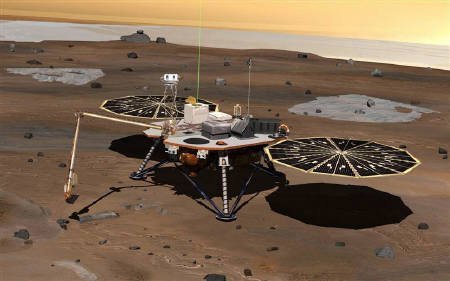NASA's Phoenix lander closed in on Mars Saturday, healthy and on course for touchdown Sunday evening near the Red Planet's northern polar cap.

This artist's conception shows NASA's Phoenix Mars Lander as it monitors the atmosphere overhead with a laser radar and reaches out to the soil below with the spacecraft fully deployed on the surface of Mars. (NASA Handout)
Engineers at the Jet Propulsion Laboratory in Pasadena, Calif., decided to forego a course-correction rocket firing late Saturday but left open the option for a final trajectory tweak Sunday eight hours before atmospheric entry.
"This is a very exciting day," said Douglas McCuistion, director of NASA's Mars exploration program. "The atmosphere here at JPL is electric. ... The big event is coming tomorrow. It's really just a beehive of activity adding to the excitement and enthusiasm around here."
But Phoenix scientist Peter Smith said Saturday he is a little nervous about the landing due late the following day.
"There's a lot of uncertainties left. ... Mars is always there to throw those uncertainties at us," added McCuistion of what NASA calls "the scariest seven minutes of the mission" -- the period of hyper-deceleration and descent onto the Red Planet.
An earlier trajectory correction was scrubbed Saturday because "Phoenix is so well on course for its Sunday-evening landing on an arctic Martian plain that the team decided it was not necessary," the U.S. space agency's Jet Propulsion Laboratory (JPL) in Pasadena, California, which controls the mission, said on its website.
Phoenix will enter the Martian atmosphere at around 2331 GMT Sunday at about 21,000 kilometers (13,000 miles) per hour and rely on its thermal shield, then a parachute followed by a bank of pulse thrusters, to slow down to a mere eight kph (five mph) ahead of touchdown on the circumpolar region known as Vastitas Borealis -- akin to northern Canada in Earth's latitude.
Phoenix will become the first spacecraft to land on the Martian arctic surface, digging into the polar ice in a new three-month mission searching for signs of life.